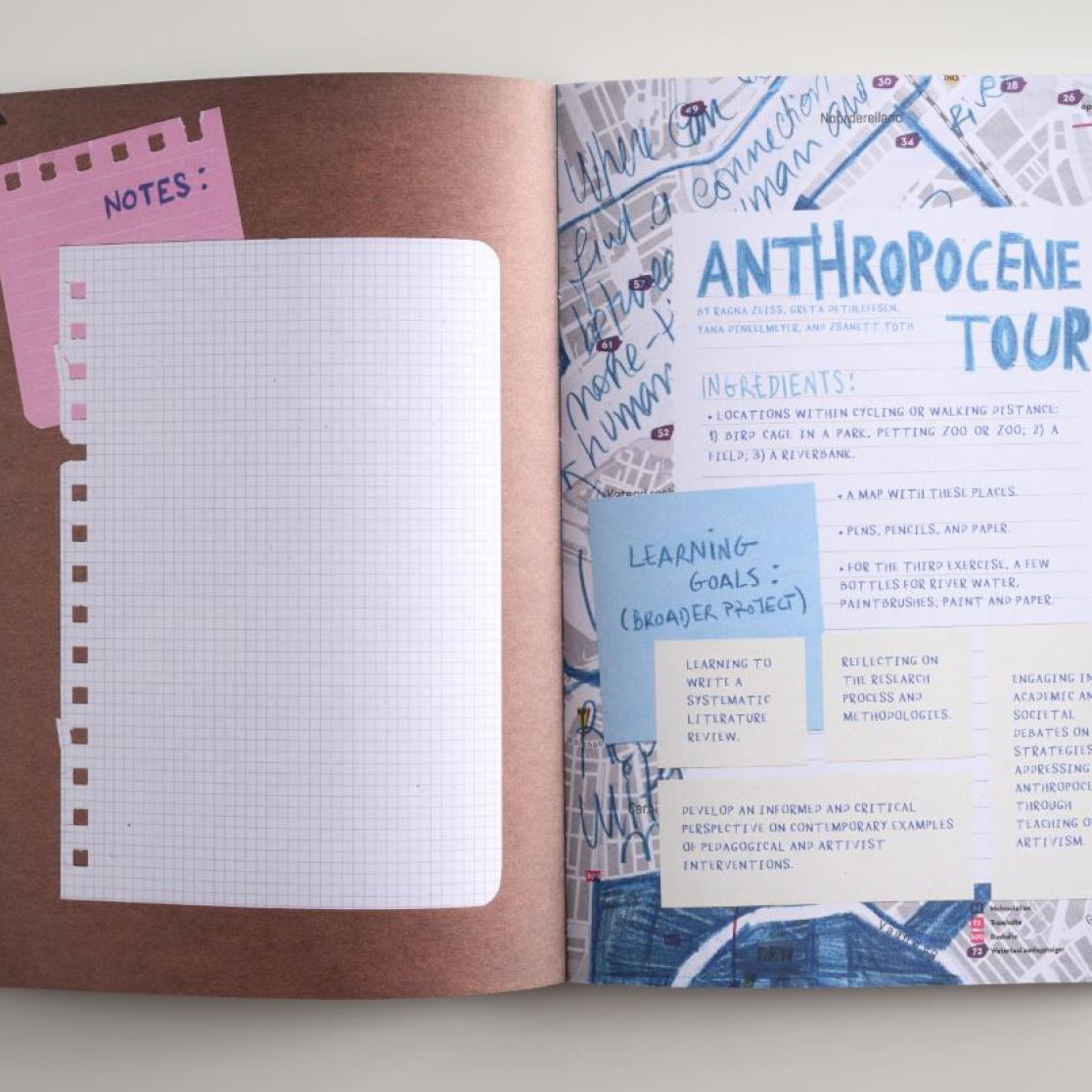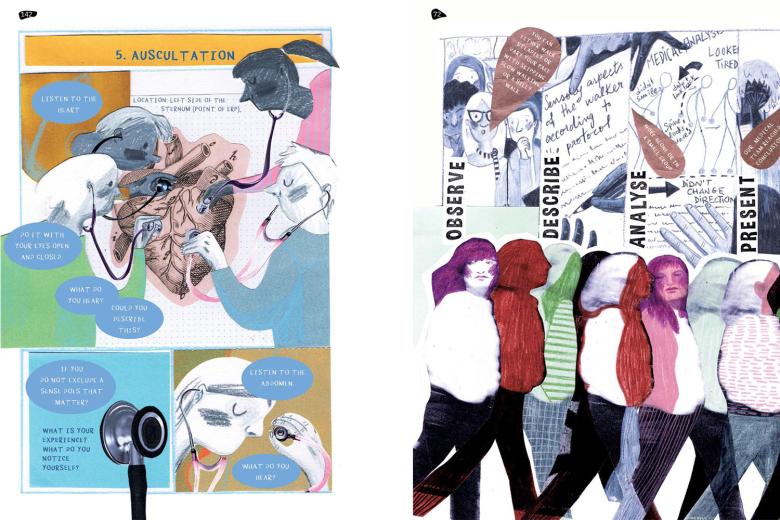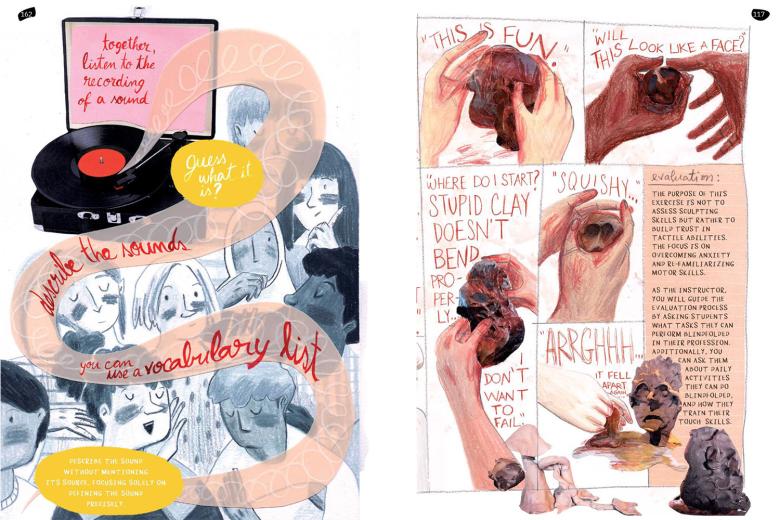Come to your senses: enrich your life and learning
For four years, Emilie Sitzia has studied how we can rediscover our senses and use them to enhance academic learning. To allow everyone to benefit from her research, she teamed up with Elene Kadagidze, illustrator Tânia Alexandra Cardoso, as well as teachers and students to create ‘Come to Your Senses’, a senses-based learning guide which is available as softcover and open access e-version.
When Emilie Sitzia started this project, the initial goal was to develop methods for students to use their senses in learning, bridging the gap between academic knowledge and practical application. She also sought to move beyond traditional academic approaches by incorporating sensory experiences more broadly. “To be honest, we weren’t that sure where the project would take us,” laughs Sitzia, who was quick to turn this into a strength. “We really doubled down on co-creating with students and the results were amazing.”
After the customary literature reviews, Sitzia and her team of ambassadors across all faculties conducted interviews with, for example, course designers, dancers, sommeliers, and cooks. “We wanted to understand how different practitioners use their senses and how they communicate or teach that.” She experimented with designing sensory exercises for students. “Often the actual learning outcomes were quite different from what we had expected. But giving students freedom led to a lot of creativity.” She remembers an exercise that involved eating a rather bland biscuit very slowly and describing the sensory experiences leading to such exuberant verbal outpourings that it escalated into a rap battle.
Sitzia had always been adamant that the project’s findings be of immediate use in teaching and so uploaded all the protocols she developed for free use. “But we saw that standard academic PDFs weren’t adopted by teachers, so we wanted to communicate the importance and richness of sensory learning more effectively and creatively.” The result is a lush graphic novel making the methodology and benefits of senses-based learning tangible.
The text continues below the image.

Emilie Sitzia is associate professor at the Department of History at Maastricht University. She studied art history and literature in France, Germany and Finland. Her research interests span art, literature and museology. She is Professor by Special Appointment of Illustration at the University of Amsterdam, a chair created by the Fiep Westendorp Foundation.
Here, you can take a look inside 'Come to your senses'!
Click on the icon to view all photos.
A creative way to make research useful
“I worked with illustrator and academic Tânia Alexandra Cardoso, who did an amazing job translating the exercises into visual stories. It really captures the dynamic and often chaotic nature of sensory exploration.” The book, Come to your Senses, is aimed at a broad audience and Sitzia hopes this format will allow academics, artists, and the general public to benefit from it. “I think that traditional peer-reviewed articles are dying and that’s a good thing too. Academic discussion is fantastic but we need more creative ways to make our research accessible to as many people as possible.”
While initially intended for a classroom setting, Come to your Senses quickly became more. Besides an academic introduction, it includes practical instructions, examples and space for note-taking and thus acts mostly as a workbook. While professional illustrations make up the lion’s share, there are plenty of sensory maps from students. “We wanted readers to understand that there’s no right or wrong – and that your artistic talent isn’t the limiting factor when rediscovering your senses.”
The book is almost intimidating in its disorienting richness – which makes sense in a culture used to sensory disengagement. “We don’t use our senses enough. We live in a very visual world but everything else has taken a backseat. Many of our students couldn’t even distinguish the smells of rosemary and mint”, remembers Sitiza, not entirely without a hint of Gallic indignation. “Reconnecting with and training your senses is crucial, not just for learning but for how you experience life in general.”

How and why to reconnect with your senses
Reconnecting is a very deliberate word here. “One of the things that struck me when interviewing cooks, but also talking to students, was that we are often not aware of our own training. When as a child, you taste your grandma's chocolate cake or you’re licking the spoon, etc – all of this is actually education. Unfortunately we stop this process in school already.” This means that by the time people enter university their ability to identify and name sense impressions have atrophied to the point where one rarely hears words like rugose, petrichor, acrid, or susurrant bandied about.
Simple exercises, like sensory deprivation to focus on one sense, help getting reacquainted with one’s sensory apparatus and thus develop greater awareness of the surrounding world and the impact we have on it. Sitzia sees a growing appetite across faculties for integrating sensory methods into teaching and research. “It’s not just how effective it is, but also how joyful it is for both students and teachers. The playful nature and unexpected learning outcomes are really stimulating.”
“When as a child, you taste your grandma's chocolate cake or you’re licking the spoon, etc – all of this is actually education.”
Emilie SitziaLearning is more than consuming digital information
Memorisation, the literature suggests, happens in a multi-sensory way. To test this, Sitzia conducted one regular and one multisensory tour of Maastricht, both of them overloading participants with information. “The multisensory group, who smelt the incense that was used at burials at the Vrijthof, or the herbs at the Roman spa had a much greater recall of the many dates and facts they were told.”
When storing and integrating information, the brain can link them to sensory impressions. “We asked students what their subject or research smells like and most of them answered ‘dust’ and ‘overheated laptop’, which is really depressing.” Foregrounding contextual learning through sensory engagement is not to denigrate the convenience and flexibility the technology gives us. “Digital access to information is a big win for education. However, this shouldn’t, and doesn’t have to, come at the expense of meaningfully experiencing something in a social context, i.e. learning in a creative classroom setting.”

Lasting impact at UM and beyond
Grading for the modules and electives was challenging but rewarding. Students could choose the medium of their assessment. “It’s the most fun I’ve ever had grading,” remembers Sitzia, “the output ranged from paintings and collages to audio installations of singing mushrooms and installations of a smell-scape of Norwegian bunkers. The only essay I got was printed backwards to illustrate a point about dyslexia.”
With funding for the project running out, electives are likely to disappear but the smaller learning interventions will remain across faculties. And there’s always the book to ensure lasting impact. “The launch was really encouraging: we had around 50 people, from little children to older people; academics, artists, all sorts. In that way, it really reflected the project itself.” Sitzia is happy with what she’s achieved in the classroom but is convinced that Coming to your Senses is much broader. “It’s an invitation to everyone to rediscover their joy in learning and more generally in experiencing the richness of life.”
Text: Florian Raith
Also read
-
Tanne van de Kreeke – a former lawyer turned epidemiologist
According to Tanne, a former lawyer and now part-time Epidemiology student, the quality of research in general would improve if more people had a better understanding of epidemiology and how the field relates to research methodology. Tanne is clear about the benefits of the master’s programme.
-
UM chair Rianne Letschert nominated as informateur
Rianne Letschert, chair of the UM Executive Board, has been nominated as informateur by the political party D66.
-
Ronald Janse appointed as new dean of Maastricht University Faculty of Law
The Executive Board of Maastricht University is delighted to announce the appointment of Prof. Ronald Janse as dean of the Faculty of Law.




